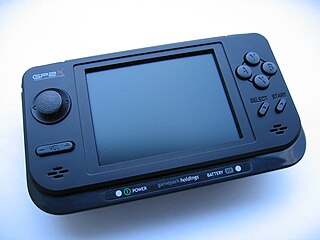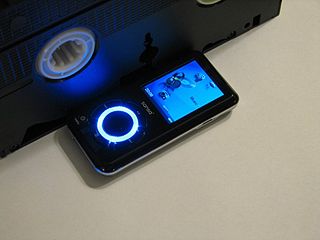
A USB flash drive is a data storage device that includes flash memory with an integrated USB interface. A typical USB drive is removable, rewritable, and smaller than an optical disc, and usually weighs less than 30 g (1 oz). Since first offered for sale in late 2000, the storage capacities of USB drives range from 8 to 256 gigabytes (GB), 512 GB and 1 terabyte (TB). As of 2023, 2 TB flash drives were the largest currently in production. Some allow up to 100,000 write/erase cycles, depending on the exact type of memory chip used, and are thought to physically last between 10 and 100 years under normal circumstances.
The Nomad was a range of digital audio players designed and sold by Creative Technology Limited, and later discontinued in 2004. Subsequent players now fall exclusively under the MuVo and ZEN brands.
Picture Transfer Protocol (PTP) is a protocol originally developed by the Photographic and Imaging Manufacturers Association (PIMA) to allow the transfer of images from digital cameras to computers and other peripheral devices without the need for additional device drivers. The protocol was standardized by the ISO in 2005. The current version of the standard is ISO 15740:2013.
The Media Transfer Protocol (MTP) is an extension to the Picture Transfer Protocol (PTP) communications protocol that allows media files to be transferred automatically to and from portable devices. Whereas PTP was designed for downloading photographs from digital cameras, Media Transfer Protocol allows the transfer of music files on digital audio players and media files on portable media players, as well as personal information on personal digital assistants. MTP is a key part of WMDRM10-PD, a digital rights management (DRM) service for the Windows Media platform. In 2011, it became the standard method to transfer files to and from Android.

The Personal Jukebox was the first consumer hard drive-based digital audio player. Introduced in 1999, it preceded the Apple iPod, SanDisk Sansa, and other similar players. It was designed and developed by Compaq Research starting in May 1998. Compaq did not release the player themselves, but licensed the design to HanGo Electronics Co., Ltd. of South Korea.

The USB mass storage device class is a set of computing communications protocols, specifically a USB Device Class, defined by the USB Implementers Forum that makes a USB device accessible to a host computing device and enables file transfers between the host and the USB device. To a host, the USB device acts as an external hard drive; the protocol set interfaces with a number of storage devices.

ZEN is a series of portable media players designed and manufactured by Creative Technology Limited from 2004 to 2011. The players evolved from the NOMAD brand through the NOMAD Jukebox series of music players, with the first separate "ZEN" branded models released in 2004. The last Creative Zen player, X-Fi3, was released at the end of 2011.

The Dell Digital Jukebox or just Dell DJ is a brand name for a series of digital audio players sold by the Dell corporation.

A portable media player (PMP) or digital audio player (DAP) is a portable consumer electronics device capable of storing and playing digital media such as audio, images, and video files. The data is typically stored on a compact disc (CD), Digital Versatile Disc (DVD), Blu-ray Disc (BD), flash memory, microdrive, SD cards or hard drive; most earlier PMPs used physical media, but modern players mostly use flash memory. In contrast, analogue portable audio players play music from non-digital media that use analogue media, such as cassette tapes or vinyl records.

The GP2X is a Linux-based handheld video game console and portable media player developed by South Korean company GamePark Holdings. It was released on November 10, 2005, in South Korea only.
The ShoqBox is a flash memory-based MP3 player from Philips with attached speakers. Its name is formed from a portmanteau of "shock" and "boombox".

A live USB is a portable USB-attached external data storage device containing a full operating system that can be booted from. The term is reminiscent of USB flash drives but may encompass an external hard disk drive or solid-state drive, though they may be referred to as "live HDD" and "live SSD" respectively. They are the evolutionary next step after live CDs, but with the added benefit of writable storage, allowing customizations to the booted operating system. Live USBs can be used in embedded systems for system administration, data recovery, or test driving, and can persistently save settings and install software packages on the USB device.

The Buffalo TeraStation network-attached storage series are network-attached storage devices.

The RioForge is a digital audio player that was produced by Rio Audio, Inc. While it competed in the same market as Apple Inc's iPod mini, it is considerably different as it plays from internal memory, SD card, or FM broadcast and runs on a single AAA battery.

The Sansa e200 series is a portable media player developed by SanDisk and released on January 5, 2006. The device is available in four capacities of Flash memory: 2 GB (e250), 4 GB (e260), 6 GB (e270), and 8 GB (e280). All players have a 1.8-inch, TFT LCD display with a resolution of 176 by 220 pixels. Certain files, if not in a format accepted by the player's original firmware, must first be converted with the Sansa Media Converter Windows software. This will convert images to bitmap format (.bmp) and videos to MJPEG, for v1 models. On v2 players it will convert videos to DivX and simply resize images. It is not possible to simply copy videos to the device, even if they seem to be in the correct format; trying to access them displays an error message.

The Archos AV series is a line of portable media players from the company called Archos that was released through 2003 to 2005. This series introduced the digital video recorder for the AV500, an optional feature that would be compatible in subsequent players. Although the AV series did not have standalone digital audio players, Archos did release them under the concurrently released Gmini series.

The Archos Jukebox is a series of Archos portable audio players from 2000 through 2002.
The French consumer electronics company Archos manufactured a number of products which have since been discontinued.
The following is a list of software used in the Personal Jukebox. It includes computer-based software, as well as device software














